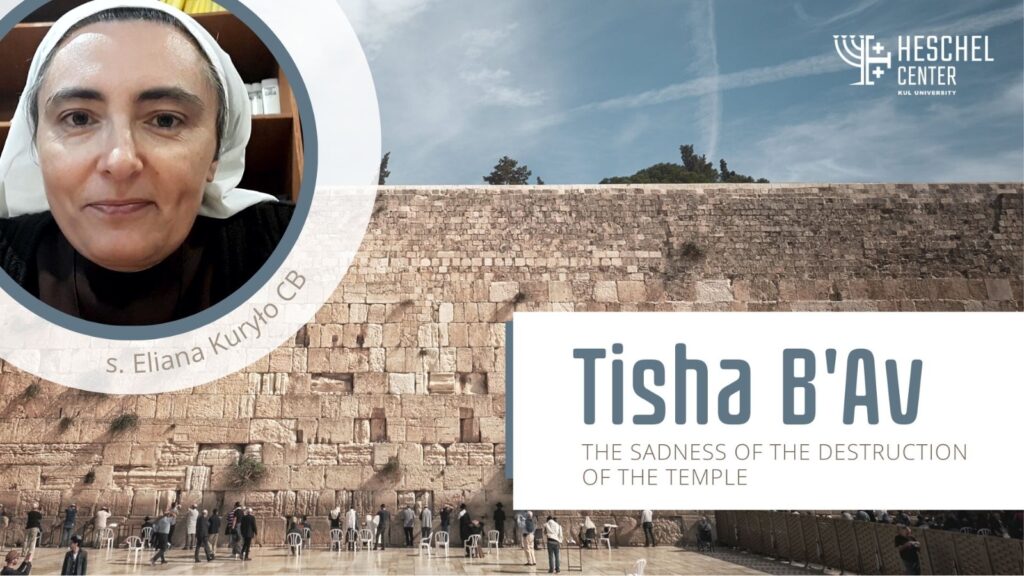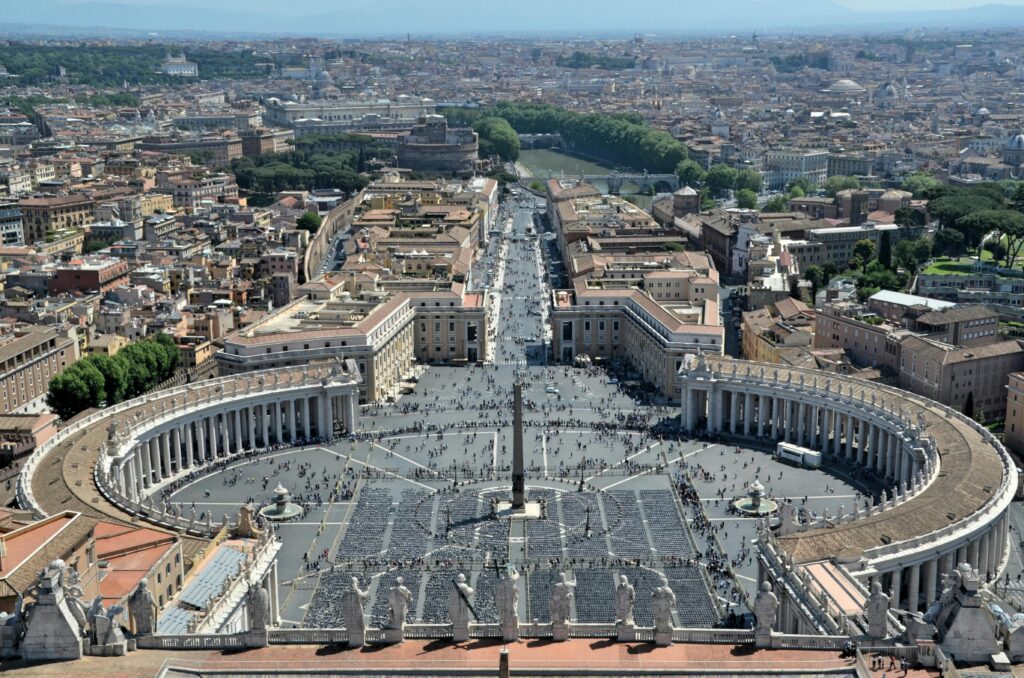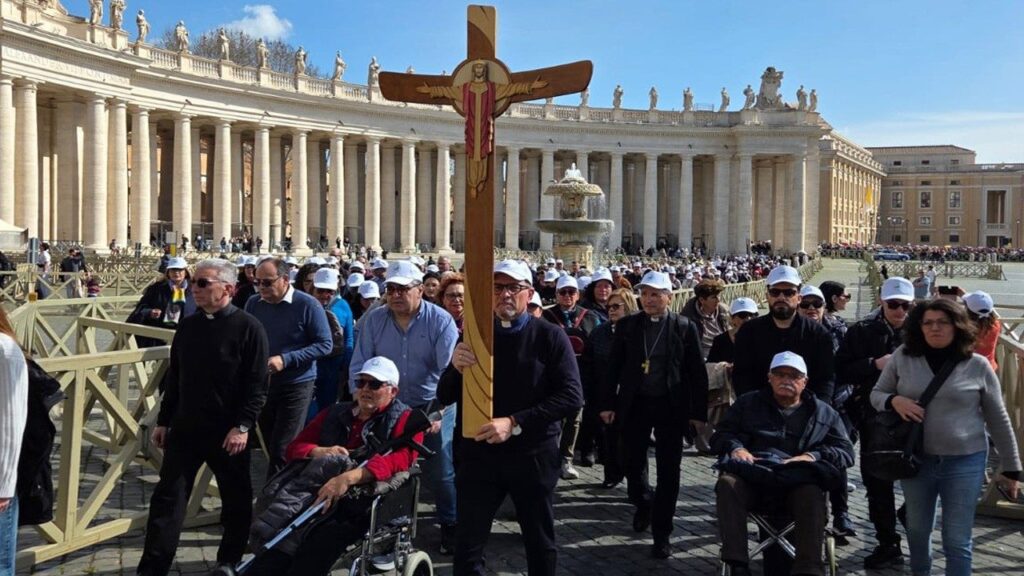Tisha B’Av – the saddest day in the Jewish calendar
On this day, no one wishes another person a “good” Tisha B’Av. In the Jewish year, this day occupies an extremely important place. Today is Tisha B’Av (Hebrew: תשעה באב – the ninth day of the month of Av) – the day of commemoration of the destruction of the First and Second Temple of Jerusalem, […]

On this day, no one wishes another person a “good” Tisha B’Av. In the Jewish year, this day occupies an extremely important place. Today is Tisha B’Av (Hebrew: תשעה באב – the ninth day of the month of Av) – the day of commemoration of the destruction of the First and Second Temple of Jerusalem, a day of mourning and strict fasting.
How it is celebrated in Israel and what is its significance is explained for the Heschel Center of the Catholic University of Lublin by Sr. Eliana Kurylo CB, the tutor of Biblical Hebrew and the superior of the sisters of the Community of the Beatitudes in Emmaus-Nicopolis, Israel. This commentary is a part of a series in which we explain and discuss the annual Jewish holidays.
The First Temple was destroyed during the Babylonian invasion in 586 B.C.E., and the Second Temple was destroyed by the Romans in A.D. 70. The Talmud says that the reason for the destruction of the First Temple was idolatry and immoral behavior, and the reason for the fall of the Second Temple was too little commitment to Torah study, which later led to misunderstandings and disputes. “People have lost respect for themselves and God and have come to see others as a threat to their personal success. This history of divisions according to the rabbis was the beginning of the fall, the lack of discernment of the signs of time and so opening the doors to the subsequent destruction and expulsion of the Jews from their land” – emphasizes Sr Kuryło.
Preparations for the commemoration of these sad events begin three weeks before the ninth day of the month of Av. From the first day of that month begins a period of restraints during which no parties are organized and when many refrain from eating meat and drinking wine or other alcoholic beverages. On Tisha B’Av, in synagogues, the parochet, the curtain covering the door of the Aron ha-kodesh is removed. The Torah scrolls which are kept there are devoid of all ornaments and decorations at that time.
The ninth day of the month of Av – Tisha B’Av – is under strict fasting: for 25 hours no food is eaten and no water is drunk. “It is a time dedicated to mourning and self-reflection. It is also a time when it is remembered that despite the pain and destruction, God has not abandoned his people until this day” – explains the superior of the sisters of the Community of the Beatitudes.
“The awareness of grief because of the destroyed Temples is a constant part of Jewish everyday life. (…) Every day prayers are said asking for its reconstruction. Tisha B’Av teaches that everyone has an inner temple within them, which is filled with the presence of God. (…) Every home can be imbued with God’s holiness if its inhabitants allow it to become a part of their everyday life” – emphasizes Sr Kuryło.
We publish the text of the commentary:
Commemoration and not a feast day
In this series of articles we discuss Jewish holidays. Today we will talk about the saddest event in the Jewish calendar commemorating the destruction of the First and Second Jerusalem Temple. The commemoration always falls in the middle of Israeli summer, on the ninth day of the Jewish month of Av. No one calls this memory a feast day and no one wishes their relatives or friends a “good” Tishah B’Av. It is a day filled with great mourning and strict fasting because what remains of the former Temple is its main square and Kotel, the Western Wall which is the only space available to the Jewish prayer there.
Tishah B’Av in history and in Jewish tradition
The First Temple was destroyed during the Babylonian invasion in 586 B.C. The rabbis teach that the cause of its fall was the people’s spiritual laziness. Midrash Eichah Rabbasi 1:35 relates the following story: “A man would approach his friend in Jerusalem and request: Would you please read a page of the Written Law for me? Would you please study with me a chapter of Oral Law? The response would be: I have no strength. The Master of the Universe then replied: I promise that the day will come when you will really be drained of all strength, as it says they fled without strength from the pursuer (Lm 1,6).”
Talmud relates that the reason for the fall of the First Temple was idolatry, immorality and bloodshed and the reason for the fall of the Second Temple was senseless hatred (Yoma 9b). “Rabbi Yose taught: In early days, they avoided an increase of disputation in Israel… But when there was an increase of students of Shammai and Hillel who did not serve (i.e. study from) their teachers as much as necessary, disputes proliferated in Israel and the Torah became tantamount to two Torahs (Sanhedrin 88b).” During the Second Temple era, a significant number of students weakened in their commitment to Torah study. They did not take the time to study with their teachers, so eventually they failed to understand their tradition properly, which later led to misunderstandings and disputes. People lost respect for one another and for God and began to see others as a threat to their personal success. This is one of the reasons why the so-called “bad language” (speaking badly about others) is perceived as one of the worst sins. This history of divisions, according to the rabbis, was the beginning of the fall, the lack of discernment of the signs of the times and the opening towards the subsequent destruction and the expulsion of the Jews from their land.
The customs of Tishah B’Av
The preparation time for the day commemorating the fall of the two Temples begins three weeks before the 9th of Av. During that period people avoid scheduling their weddings as well as getting haircuts. From the first day of the month of Av, a fast is adopted during which meat and alcohol are cut out of the regular diet, bathing for recreational purposes is avoided and freshly washed clothes are not worn. The 9th of Av is a strict fast: no food or water is taken for 25 hours, washing, shaving and wearing leather shoes is avoided as well. This is a time of mourning and self-reflection. It is also a time when it is remembered that despite the pain and destruction, God has never abandoned his people.
The awareness and grief because of the destruction of the Temple is a constant part of Jewish everyday life. It is customary that if someone plasters their home, they should leave a square of wall opposite the entrance unfinished; when a woman adorns herself, she should omit some of her ornaments; a bridegroom should place ashes upon his head before the wedding ceremony and at its conclusion a glass should be broken and a prayer in memory of the destroyed Temple should be recited. Every day there are prayers recited asking God for the Temple to be rebuilt.
The significance of the Temple today
Tishah B’Aw teaches that everyone has an inner temple that is filled with the presence of God as long as we seek intimacy with Him and try to avoid “bad tongue”. Sages see each house as a mini sanctuary. According to the famous Jewish scholar Ramban, the sanctuary (Mishkan) was meant to be a replica of Sara’s tent – the prototype of Jewish home. Every home can be filled with God’s holiness if its inhabitants will allow it to enter.
About the author
Sr Eliana Kuryło CB – an English teacher and translator by education, a tutor of ancient Hebrew at the Biblical Institute in Toulouse. She led Bible workshops at the student chaplaincies in New Zealand and Toulouse, France. She has been involved in Jewish-Christian dialogue for many years. She is currently the superior of the sisters at the Community of the Beatitudes in Emmaus-Nicopolis, Israel.
Related

Holy Week 2025 at the Vatican: Calendar. Faith, Tradition, and a Long-Awaited Canonization
Exaudi Staff
02 April, 2025
1 min

Young Catholic Entrepreneurs: Stories of Faith, Courage, and Business Success
Javier Ferrer García
02 April, 2025
4 min

Echoes of the Jubilee of the Missionaries of Mercy
José María Montiu de Nuix
02 April, 2025
4 min

Discover Your Vocation: The Divine Path to a Full and Holy Life
Patricia Jiménez Ramírez
01 April, 2025
5 min
 (EN)
(EN)
 (ES)
(ES)
 (IT)
(IT)

